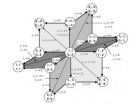(Press-News.org) CAMBRIDGE, Mass. — The quest to harness a broader spectrum of sunlight's energy to produce electricity has taken a radically new turn, with the proposal of a "solar energy funnel" that takes advantage of materials under elastic strain.
"We're trying to use elastic strains to produce unprecedented properties," says Ju Li, an MIT professor and corresponding author of a paper describing the new solar-funnel concept that was published this week in the journal Nature Photonics.
In this case, the "funnel" is a metaphor: Electrons and their counterparts, holes — which are split off from atoms by the energy of photons — are driven to the center of the structure by electronic forces, not by gravity as in a household funnel. And yet, as it happens, the material actually does assume the shape of a funnel: It is a stretched sheet of vanishingly thin material, poked down at its center by a microscopic needle that indents the surface and produces a curved, funnel-like shape.
The pressure exerted by the needle imparts elastic strain, which increases toward the sheet's center. The varying strain changes the atomic structure just enough to "tune" different sections to different wavelengths of light — including not just visible light, but also some of the invisible spectrum, which accounts for much of sunlight's energy.
Li, who holds joint appointments as the Battelle Energy Alliance Professor of Nuclear Science and Engineering and as a professor of materials science and engineering, sees the manipulation of strain in materials as opening a whole new field of research.
Strain — defined as the pushing or pulling of a material into a different shape — can be either elastic or inelastic. Xiaofeng Qian, a postdoc in MIT's Department of Nuclear Science and Engineering who was a co-author of the paper, explains that elastic strain corresponds to stretched atomic bonds, while inelastic, or plastic, strain corresponds to broken or switched atomic bonds. A spring that is stretched and released is an example of elastic strain, whereas a piece of crumpled tinfoil is a case of plastic strain.
The new solar-funnel work uses precisely controlled elastic strain to govern electrons' potential in the material. The MIT team used computer modeling to determine the effects of the strain on a thin layer of molybdenum disulfide (MoS2), a material that can form a film just a single molecule (about six angstroms) thick.
It turns out that the elastic strain, and therefore the change that is induced in electrons' potential energy, changes with their distance from the funnel's center — much like the electron in a hydrogen atom, except this "artificial atom" is much larger in size and is two-dimensional. In the future, the researchers hope to carry out laboratory experiments to confirm the effect.
Unlike graphene, another prominent thin-film material, MoS2 is a natural semiconductor: It has a crucial characteristic, known as a bandgap, that allows it to be made into solar cells or integrated circuits. But unlike silicon, now used in most solar cells, placing the film under strain in the "solar energy funnel" configuration causes its bandgap to vary across the surface, so that different parts of it respond to different colors of light.
In an organic solar cell, the electron-hole pair, called an exciton, moves randomly through the material after being generated by photons, limiting the capacity for energy production. "It's a diffusion process," Qian says, "and it's very inefficient."
But in the solar funnel, he adds, the electronic characteristics of the material "leads them to the collection site [at the film's center], which should be more efficient for charge collection."
The convergence of four trends, Li says, "has opened up this elastic strain engineering field recently": the development of nanostructured materials, such as carbon nanotubes and MoS2, that are capable of retaining large amounts of elastic strain indefinitely; the development of the atomic force microscope and next-generation nanomechanical instruments, which impose force in a controlled manner; electron microscopy and synchrotron facilities, needed to directly measure the elastic strain field; and electronic-structure calculation methods for predicting the effects of elastic strain on a material's physical and chemical properties.
"People knew for a long time that by applying high pressure, you can induce huge changes in material properties," Li says. But more recent work has shown that controlling strain in different directions, such as shear and tension, can yield an enormous variety of properties.
One of the first commercial applications of elastic-strain engineering was the achievement, by IBM and Intel, of a 50 percent improvement in velocity of electrons simply by imparting a 1 percent elastic strain on nanoscale silicon channels in transistors.
INFORMATION:
The work was done with Ji Feng of Peking University and Cheng-Wei Huang, and was supported by the U.S. National Science Foundation, the U.S. Air Force Office of Scientific Research, and the National Natural Science Foundation of China.
Written by David L. Chandler, MIT News Office
END
An insect growth regulator is one of the latest technologies U.S. Department of Agriculture (USDA) scientists are adding to their arsenal to help fight house flies that spread bacteria to food.
Agricultural Research Service (ARS) scientists at the agency's Center for Medical, Agricultural, and Veterinary Entomology in Gainesville, Fla., are using an insect growth regulator called pyriproxyfen to kill house flies that spread bacteria that can cause diarrhea and other illnesses. When pyriproxyfen is applied to larval breeding sites such as manure, it mimics a hormone in ...
New combinations of medical imaging technologies hold promise for improved early disease screening, cancer staging, therapeutic assessment, and other aspects of personalized medicine, according to Ge Wang, director of Virginia Tech's Center for Biomedical Imaging, in a recent paper that appeared in the refereed journal PLOS ONE.
The integration of multiple major tomographic scanners into a single framework "is a new way of thinking in the biomedical imaging world" and is evolving into a "grand fusion" of many imaging modalities known as "omni-tomography," explained Wang, ...
Durham, NC – The question of how life began on a molecular level has been a longstanding problem in science. However, recent mathematical research sheds light on a possible mechanism by which life may have gotten a foothold in the chemical soup that existed on the early Earth.
Researchers have proposed several competing theories for how life on Earth could have gotten its start, even before the first genes or living cells came to be. Despite differences between various proposed scenarios, one theme they all have in common is a network of molecules that have the ability ...
Like a homeowner prepping for a hurricane, the bacterium Bacillus subtilis uses a long checklist to prepare for survival in hard times. In a new study, scientists at Rice University and the University of Houston uncovered an elaborate mechanism that allows B. subtilis to begin preparing for survival, even as it delays the ultimate decision of whether to "hunker down" and withdraw into a hardened spore.
The new study by computational biologists at Rice and experimental biologists at the University of Houston is available online in the Proceedings of the National Academy ...
On Nov. 23, 2012, at 8:54 a.m. EST, the sun erupted with an Earth-directed coronal mass ejection or CME. Experimental NASA research models, based on observations from the Solar Terrestrial Relations Observatory (STEREO) and the ESA/NASA mission the Solar and Heliospheric Observatory, show that the Nov. 23 CME left the sun at speeds of 375 miles per second, which is a slow to average speed for CMEs. This is the third Earth-directed CME since Nov. 20.
Not to be confused with a solar flare, a CME is a solar phenomenon that can send solar particles into space and can reach ...
Montreal, November 26, 2012 – What if factory foremen treated their workers less like the machines they operate, and more like people, with personality strengths and differences? Surely the workers would benefit, but might the employers also see positive results in the workplace, as well as being able to cut costs?
That's what Concordia researcher Mohammed Othman set out to prove in his paper "Integrating workers' differences into workforce planning," recently published in the journal Computers & Industrial Engineering.
Currently, explained Othman, two types of researchers ...
COLUMBUS, Ohio -- If you want to get rid of unwanted, negative thoughts, try just ripping them up and tossing them in the trash.
In a new study, researchers found that when people wrote down their thoughts on a piece of paper and then threw the paper away, they mentally discarded the thoughts as well.
On the other hand, people were more likely to use their thoughts when making judgments if they first wrote them down on a piece of paper and tucked the paper in a pocket to protect it.
"However you tag your thoughts -- as trash or as worthy of protection -- seems to ...
A study led by academics at the University of Bristol's Intelligent Systems Laboratory and the School of Journalism at Cardiff University have used Artificial Intelligence (AI) algorithms to analyse 2.5 million articles from 498 different English-language online news outlets over ten months.
The researchers found that:
• As expected, readability measures show that online tabloid newspapers are more readable than broadsheets and use more sentimental language. Among 15 US and UK newspapers, the Sun is the easiest to read, comparable to the BBC's children's news programme, ...
Among the most important techniques developed in atomic physics over the past few years are methods that enable the storage and cooling of atoms and ions at temperatures just above absolute zero. Scientists from Bangalore and Mainz have now demonstrated in an experiment that captured ions can also be cooled through contact with cold atoms and may thus be stored in so-called ion traps in a stable condition for longer periods of time. This finding runs counter to predictions that ions would actually be heated through collisions with atoms. The results obtained by the joint ...
The possible kinematics and their corresponding geometries were once regarded as an already-solved problem. The de Sitter relativity research group formed by researchers from Chinese Academy of Sciences, Tsinghua University, and Beijing Normal University, restudied the problem and showed that additional, previously unknown realizations exist of possible kinematical algebras, each of which has so(3) isotropy and a ten-generators symmetry group. They presented these geometries corresponding to all these realizations and provided a classification in an article, entitled "Geometries ...


